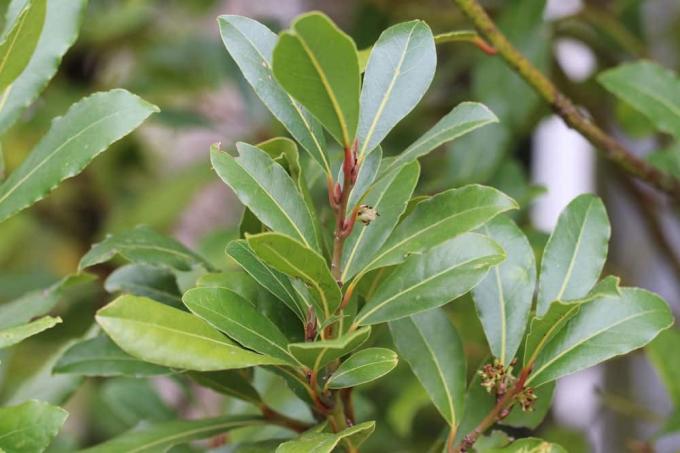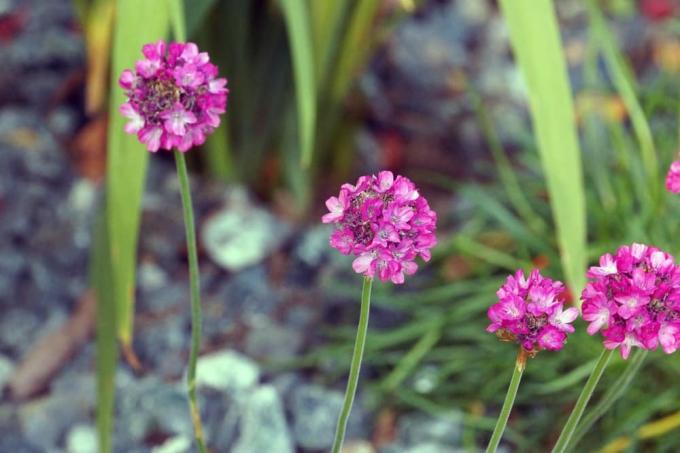

Table of contents
- Location
- Plant
- Summary
- Care
- propagation
- hibernate
- frequently asked Questions
- Worth knowing about the Great Periwinkle shortly
The Great Periwinkle (bot.: Vinca Major) is a semi-shrub that is rarely found in the wild. The main areas of distribution of the evergreen shrub include the western and central Mediterranean and parts of Asia Minor. Despite the relatively warm climate, which usually prevails in the countries of origin of the periwinkle, the unspeakably decorative subshrub is hardy. In fact, most of the varieties of the periwinkle, which otherwise belongs to the family of the belongs to the dogbane family (Apocynaceae), even icy temperatures of up to -15 °C are harmless survive. Nevertheless, it is advisable to take special precautions in rough locations to get the periwinkle safely through the winter.
Location
The large periwinkle prefers soil that is rich in humus and consistently moist. In the case of "poor" soil, it is therefore advisable to upgrade it with potting soil and/or mature compost before planting. In addition, the location should be shaded to half-shaded. Pure green varieties can even be planted directly in the shade. It is worth mentioning that Vinca Major tolerates root pressure surprisingly well, so that it can even be planted under trees, shrubs and bushes without any problems. In the case of varieties with colorful foliage, on the other hand, the leaf pattern can quickly become deformed in overly shady locations. Nevertheless, it is also important to avoid too much light here, especially since Vinca Major is generally very sensitive to the winter sun.
Plant
Since the periwinkle spreads a lot, the individual plants should be planted at least 35 to 40 cm apart. As a result, only five to a maximum of seven plants may be planted per square meter, no matter how dainty the young seedlings may appear. In addition, there should be no other plants in the immediate vicinity that could fall victim to the Vinca Major's urge to spread. It is also advisable to thoroughly clear the bed of weeds, especially since later weeding is difficult in view of the dense growth of the large periwinkle. It is also advisable to rake up the surrounding ground a little so that the side shoots can root more easily and the plant itself is better supplied with rain or irrigation water.
When digging the planting hole, make sure that it is about twice as wide as the root system. Depending on the soil conditions, it may be advisable to add some mature compost mixed with ordinary garden soil in a ratio of 1/3 to the hole until it is about 3/4 full. The still loose soil should then be watered well until it becomes muddy. Only now does the large periwinkle come into the planting hole. Then the hole is completely filled with soil, which should be pressed down a little at the end. Incidentally, spring is the ideal time for planting, although periwinkle can be planted in late summer or early fall if necessary. However, planting in midsummer is strictly discouraged.
Summary
- Remove weeds from the bed
- Rake bed
- Dig planting holes
- Fill planting holes 3/4 full with loose soil (add compost if necessary)
- watering soil
- Use periwinkle
- Fill the hole with soil
- Press down the soil to finish
Care
If a suitable location with good soil quality has been chosen, the large periwinkle proves to be much easier to care for than is commonly assumed. In fact, care is limited to an annual pruning in spring and watering as needed. With regard to the pruning, it should be mentioned that it is primarily used for shaping. In addition, it also prevents the Vinca Major from spreading too much. In addition, a targeted thinning out of the plant can be a tried and tested remedy against the development of various plant diseases and infestation by fungi. However, it should be noted in this context that only clean plants should be cut Tools may be used, otherwise there would be an unwanted disease transmission from other plants could come. Apart from that, the scissors used should be as sharp as possible so that the shoots to be cut are not squeezed too much.
Incidentally, the best time to cut back is shortly before the expulsion phase, which can start as early as the beginning of February, depending on the weather. There is hardly any reason to worry about being able to cut off too much with the pruning-resistant and rapidly regrowing periwinkle. The only important thing is that the remaining shoots have enough leaves. Also, some nodes should be left for new roots to grow from.
propagation
The propagation of the large periwinkle turns out to be very easy. All that is necessary for this are short pieces of shoots with at least one pair of leaves, which are usually only have to be pricked into the moist soil from their cut surface in order to draw new roots can. Alternatively, of course, side shoots with nodes that have already formed tender roots can also be used. In both cases, it is advisable to take the cuttings from healthy, well-growing plants.
Tip:
If you want to propagate your large periwinkle, you can leave some side shoots in the spring when pruning back until their nodes root.
hibernate
In areas with relatively mild winters, where minimum temperatures are usually well above -15°C lying, you can normally plant the periwinkle outdoors throughout the cold season without hesitation permit. Depending on the location, however, it may be advisable to provide additional protection from the winter sun. If, on the other hand, a particularly harsh winter is to be expected, at least some plants should be moved to a safe place to protect them from too much cold. It is advisable to place the plants in a sufficiently large flower pot with fresh potting soil.
However, you must make sure that it is neither too bright nor too warm in the winter quarters, otherwise the periwinkle threatens to sprout too early or, in the worst case, could even be damaged. In addition, periwinkle should not be watered too often in winter. Note: If you need to prune your periwinkle a bit before repotting, you can due to the pending spring pruning, really only cut off as much as absolutely necessary is.
frequently asked Questions
Although there are a number of possible causes, in most cases it is due to the leaves getting too much sunlight.
Of course you can sow the seeds. However, your large periwinkle can be propagated much easier and, above all, much faster with the help of cuttings.
Worth knowing about the Great Periwinkle shortly
- Species/Family: Shrub, belongs to the dogbane family (Apocynaceae)
- Care required: low, easy to care for, robust, undemanding is at least the original form (see flowers below)
- Flowering period: April to May with star-shaped blue, purple or white flowers (see Flowers below) on short stalks
- Foliage: Evergreen, oblong, ovate, small and leathery leaves of glossy dark green
- Habit: Groundcover, fast-growing woody semi-shrub, spreads through long rooted tendrils lying on the ground, strong spread through runners
- Height: 20 to 30 cm
- Location: sunny to shady and cool, with a spot with strong morning sun being ideal (see also location below), humus-rich and loose soil that should be dry rather than too moist
- Planting Time: Anytime as long as the ground is not frozen
- Pruning: tolerates severe pruning in spring to avoid spreading too much, but not necessary
- Partners: Astilbe, Christmas rose, fern, foxglove, shade grasses, forest goat's beard
- Propagation: Division from spring to summer, the plants root on the low-lying leaf nodes, so here rooted or unrooted cuttings can be taken at any time (as long as the ground is not frozen). can
- Care: water during long periods of drought, no fertilization if fallen leaves are left lying (processed into humus by soil organisms)
- Hibernation: the original form is quite hardy, the breeds usually need winter protection, if you are unsure, simply cover with some brushwood is enough
- Diseases/problems: hardly any problems if the location is right
particularities
- is native from the Mediterranean region to the Caucasus
- also copes with the deepest shade under trees
- all parts of the plant are poisonous
- also good to cultivate in the hanging basket
kind
- Small periwinkle (Vinca minor): height 10-15 cm; otherwise identical to greater periwinkle, only less susceptible
sorts
- 'Bowles': flowers in a dark purple
- 'Gertrude Jeckyll': White and very free-flowering variety when established and given good winter protection
- 'Reticulata': pleases with a yellow-green center as an unusual leaf pattern
- 'Rubra': stands out due to its purple flowers
- 'Variegata': quickly catches the eye with its yellowish-white foliage
 garden editorial
garden editorial I write about everything that interests me in my garden.
Learn more about garden plants - care

Lepidoptera, Faboideae - characteristics and representatives from A-Z
From the tropics to the arctic, legumes colonize our planet with more than 12,000 species. They serve us as ornamental and food plants or annoy us as weeds. Immerse yourself in the fascinating world of butterfly blossom plants. Get to know their characteristics and meet their representatives from A-Z.

Laurel tree has brown leaves - diseases + pests on laurel
If the spice laurel suddenly gets yellow leaves, which then turn brown and possibly fall off, the cause of the disease must be found out. This is the only way to do something against the dying of the laurel tree. In many cases, the plant can be saved quite easily.

Double garden jasmine, chanterelle tree - care, cutting and propagation
A concentrated, delicate white blossom and an enchanting scent characterize the double garden jasmine, which is also known under the name mock orange. It is therefore becoming increasingly popular in local gardens as hedges and privacy screens or as a solitaire. The ornamental tree is very easy to care for and should therefore not be missing in any garden.

Laurel tree, Laurus nobilis - information on care, propagation and wintering
The laurel tree is a popular, evergreen shrub that is suitable for pot culture or also grows in mild locations in the garden. Cared for and neatly cut, the dark green, leathery foliage can provide breathtaking accents in entrance areas or on terraces. You can find out how to properly care for the laurel here.

Thrift, Armeria - Varieties, care and information on winter hardiness/toxicity
Its long flowering period and uncomplicated care make the thrift a popular perennial that knows how to make a brilliant understatement. Where other summer flowers languish in the dry, sunny location, armeria trumps with colorful flowers. Explore the most beautiful varieties, practical care instructions and well-founded information on winter hardiness and toxicity.

Catchfly, Silene viscaria - sowing, planting & care
The pitcher (Lychnis viscaria) is a perennial, bushy wild perennial belonging to the Carophyllaceae family. Since it originally comes from the Mediterranean region, it is suitable for moor gardens, for green roofs, as a hardy garden perennial and as a decorative cut flower. The plant usually flowers from May to August in a strong fire or chimney red and reaches a height of about 40 to 50 cm.



